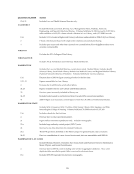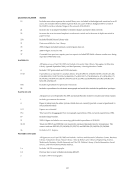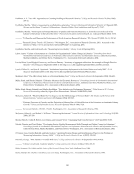13
OWNERSHIP AND ACCESS
Three years ago, the number of serials purchased increased above 1986 levels for the first time
since 1992, and in 2004‐05 the median of 22,595 subscriptions reached a new high in the history of the
time series. This is most likely due to the same reasons cited above, including increased availability of
electronic subscriptions and consortial arrangements. Research libraries purchased slightly more
monographs in 2005 than in 2004 monographs purchased has risen above 1986 levels only once in the last
nineteen years. Since 1986, the average annual increase for the serial unit cost has been 5.3%, and for the
monograph unit cost 3.2%. Both are higher than the general inflation trend during the same period, and
include both print and electronic resources (frequently with some duplication between the two media
forms). Thus, the intellectual capital purchased by libraries is declining not only due to reduced
purchasing power but also due to the degree of content duplication between the electronic and print
media.
In 1986, the typical ARL library subscribed to 15,775 serials and bought 32,425 monographs for
16,660 students and 1,124 faculty. In 2005 it bought 22,404 serials and 30,217 monographs for 21,856 students
and 1,355 faculty. Additionally, libraries are increasingly providing improved access without purchase of
materials Table 3 and Graph 3 show that the number of non‐purchased serials received by the average
ARL library increased by an annual average of 6.6% since 1986. This category consists of a number of
types of serials, including government documents, electronic serials made available free of charge with
the purchase of print counterparts, and open access journals. To some extent the increase is due to
previously uncataloged government documents added to the library catalog as they were made available
through programs such as MARCIVE. However, it is likely that emerging trends such as the open access
movement18 and institutional digital repositories19 will continue to raise the number of serials received (not
purchased) in the future. As alternative publishing models are becoming more widespread, libraries will
increase the proportion of the holdings they provide access to,20 whether they manifest themselves as serials
or other new emerging forms.
Interlibrary borrowing and lending, which showed a marked growth in the last decade, seem to be
stabilizing. Between 1986 and 2005, the number of items borrowed has more than tripled. ARL data show
research libraries are lending 126% more items today than they did 19 years ago. In 1995‐96, the cost of a
lending transaction for research libraries ranged from a low of $4.87 to a high of $16.34, with an average cost
of $9.48 or, with an adjustment for inflation, a 2004‐05 average cost of $11.81.21
18 Mary Case and Judith Matz, “Framing the Issue: Open Access” ARL: A Bimonthly Report on Research Library Issues and Actions from
ARL, CNI, and SPARC, no. 226 (February 2003): 8‐10, http://www.arl.org/scomm/open_access/framing.html.
19 Clifford A. Lynch, ʺInstitutional Repositories: Essential Infrastructure for Scholarship in the Digital Ageʺ ARL: A Bimonthly Report
on Research Library Issues and Actions from ARL, CNI, and SPARC, no. 226 (February 2003): 1‐7,
http://www.arl.org/newsltr/226/ir.html Raym Crow, “The Case for Institutional Repositories: A SPARC Position Paper”
(Washington, DC: Scholarly Publishing &Academic Resources Coalition, 2002).
20 William Y. Arms, “Quality Control in Scholarly Publishing on the Web,” The Journal of Electronic Publishing 8, no. 1 (August 2002)
and Rob Kling, Lisa Spector, and Geoff McKim, “The Guild Model,” The Journal of Electronic Publishing 8, no. 1 (August 2002).
21 Mary E. Jackson, “Measuring the Performance,” 2.
OWNERSHIP AND ACCESS
Three years ago, the number of serials purchased increased above 1986 levels for the first time
since 1992, and in 2004‐05 the median of 22,595 subscriptions reached a new high in the history of the
time series. This is most likely due to the same reasons cited above, including increased availability of
electronic subscriptions and consortial arrangements. Research libraries purchased slightly more
monographs in 2005 than in 2004 monographs purchased has risen above 1986 levels only once in the last
nineteen years. Since 1986, the average annual increase for the serial unit cost has been 5.3%, and for the
monograph unit cost 3.2%. Both are higher than the general inflation trend during the same period, and
include both print and electronic resources (frequently with some duplication between the two media
forms). Thus, the intellectual capital purchased by libraries is declining not only due to reduced
purchasing power but also due to the degree of content duplication between the electronic and print
media.
In 1986, the typical ARL library subscribed to 15,775 serials and bought 32,425 monographs for
16,660 students and 1,124 faculty. In 2005 it bought 22,404 serials and 30,217 monographs for 21,856 students
and 1,355 faculty. Additionally, libraries are increasingly providing improved access without purchase of
materials Table 3 and Graph 3 show that the number of non‐purchased serials received by the average
ARL library increased by an annual average of 6.6% since 1986. This category consists of a number of
types of serials, including government documents, electronic serials made available free of charge with
the purchase of print counterparts, and open access journals. To some extent the increase is due to
previously uncataloged government documents added to the library catalog as they were made available
through programs such as MARCIVE. However, it is likely that emerging trends such as the open access
movement18 and institutional digital repositories19 will continue to raise the number of serials received (not
purchased) in the future. As alternative publishing models are becoming more widespread, libraries will
increase the proportion of the holdings they provide access to,20 whether they manifest themselves as serials
or other new emerging forms.
Interlibrary borrowing and lending, which showed a marked growth in the last decade, seem to be
stabilizing. Between 1986 and 2005, the number of items borrowed has more than tripled. ARL data show
research libraries are lending 126% more items today than they did 19 years ago. In 1995‐96, the cost of a
lending transaction for research libraries ranged from a low of $4.87 to a high of $16.34, with an average cost
of $9.48 or, with an adjustment for inflation, a 2004‐05 average cost of $11.81.21
18 Mary Case and Judith Matz, “Framing the Issue: Open Access” ARL: A Bimonthly Report on Research Library Issues and Actions from
ARL, CNI, and SPARC, no. 226 (February 2003): 8‐10, http://www.arl.org/scomm/open_access/framing.html.
19 Clifford A. Lynch, ʺInstitutional Repositories: Essential Infrastructure for Scholarship in the Digital Ageʺ ARL: A Bimonthly Report
on Research Library Issues and Actions from ARL, CNI, and SPARC, no. 226 (February 2003): 1‐7,
http://www.arl.org/newsltr/226/ir.html Raym Crow, “The Case for Institutional Repositories: A SPARC Position Paper”
(Washington, DC: Scholarly Publishing &Academic Resources Coalition, 2002).
20 William Y. Arms, “Quality Control in Scholarly Publishing on the Web,” The Journal of Electronic Publishing 8, no. 1 (August 2002)
and Rob Kling, Lisa Spector, and Geoff McKim, “The Guild Model,” The Journal of Electronic Publishing 8, no. 1 (August 2002).
21 Mary E. Jackson, “Measuring the Performance,” 2.


















































































































































